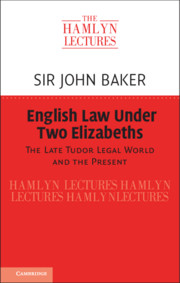Book contents
- English Law under Two Elizabeths
- English Law under Two Elizabeths
- Copyright page
- Contents
- The Hamlyn Trust
- The Hamlyn Lectures
- Preface
- Table of Statutes
- Table of Cases
- Abbreviations
- 1 The English Legal System under Elizabeth I
- 2 The Elizabethan Common Law
- 3 An Age of Common Law and an Age of Statute?
- 4 The Elizabethan Inheritance
- 5 Comparing Then and Now
- Index
3 - An Age of Common Law and an Age of Statute?
Published online by Cambridge University Press: 19 January 2021
- English Law under Two Elizabeths
- English Law under Two Elizabeths
- Copyright page
- Contents
- The Hamlyn Trust
- The Hamlyn Lectures
- Preface
- Table of Statutes
- Table of Cases
- Abbreviations
- 1 The English Legal System under Elizabeth I
- 2 The Elizabethan Common Law
- 3 An Age of Common Law and an Age of Statute?
- 4 The Elizabethan Inheritance
- 5 Comparing Then and Now
- Index
Summary
This chapter examines the common assumption that, whereas Elizabeth I’s reign was at the zenith of the age of common law, we have now moved into an age of statute. The Elizabethans themselves thought this was already happening: there were so many matters, such as poor relief and economic regulation, which the common law was powerless to tackle. The volume of legislation has continued to increase dramatically, and yet the sphere of the common law is still large and the interpretation of statutes is governed by common-law principles. The fiction of legislative intent, the concept of equity, and the mischief rule were all much the same as today’s interpretative techniques. The largest jurisprudential change has been the common law’s loss of immortality. A statute can, in an instant, extinguish an immemorial principle of law. The extinction survives the repeal of the statute, so that much of the current law is contained in repealed statutes. In this connection, the effects of the Interpretation Acts are considered. Legislation has come to dominate the law in terms of abrogative power as well as bulk, but the common law is superior in terms of clarity, flexibility and self-correction.
Keywords
- Type
- Chapter
- Information
- English Law Under Two ElizabethsThe Late Tudor Legal World and the Present, pp. 87 - 142Publisher: Cambridge University PressPrint publication year: 2021
- 1
- Cited by



